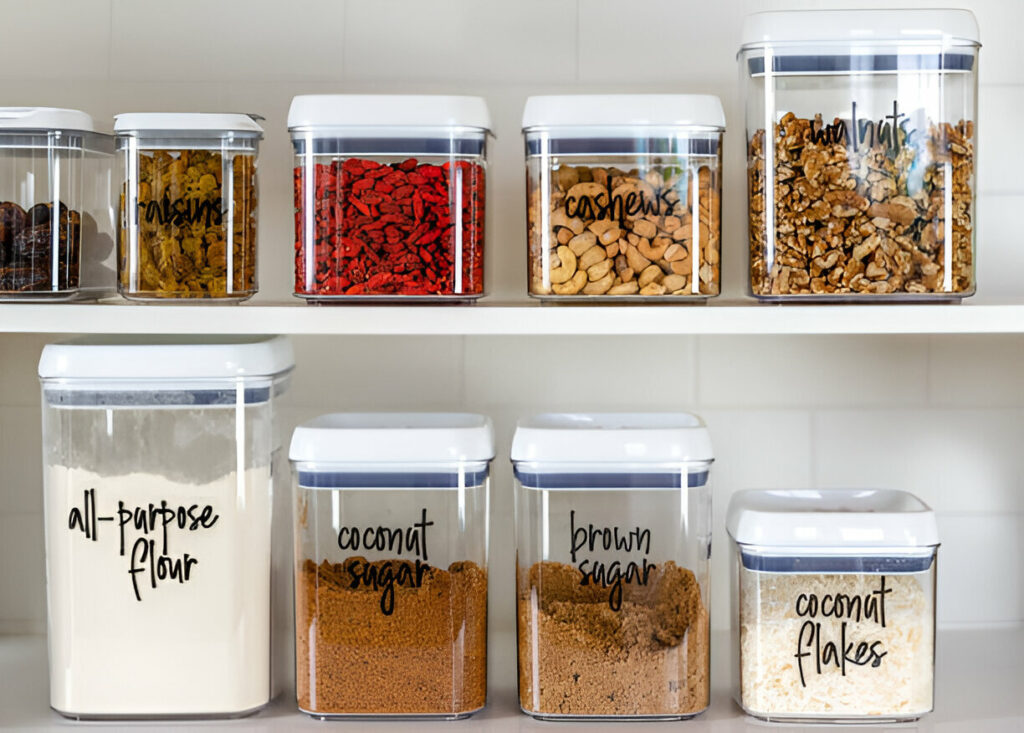A well-organized pantry makes cooking more efficient, reduces food waste, and creates a visually pleasing space. Whether you have a small cabinet or a walk-in pantry, following these steps will help you create a clutter-free, functional, and sustainable storage area for your food essentials.
Step 1: Assess Your Pantry
Start by taking stock of everything in your pantry. This initial assessment helps you understand what you have and identify areas for improvement.
- Take Inventory: List all the items in your pantry or take photos for reference.
- Evaluate Space: Note the dimensions and layout of your pantry to determine the best way to utilize the space.
Step 2: Declutter
Go through your pantry and remove any expired or unused items to free up space and keep your food fresh.
- Check Expiration Dates: Discard any food that has expired.
- Donate Unopened Items: If you have non-perishable items you won’t use, donate them to a local food bank.
- Recycle Packaging: Properly recycle any empty containers or packaging materials.
Step 3: Categorize Items
Grouping similar items together makes them easier to find and manage.
- Common Categories: Cereals, baking supplies, canned goods, snacks, spices, condiments, and grains.
- Create Zones: Assign specific areas in your pantry for each category to maintain order.
Step 4: Choose the Right Storage Containers
Invest in durable, reusable, and eco-friendly storage containers to keep your pantry organized.
- Glass Jars: Ideal for dry goods like grains, pasta, nuts, and spices.
- Cloth Bags: Great for storing flour, sugar, and other bulk dry ingredients.
- Stainless Steel Containers: Durable and easy to clean, perfect for snacks and leftovers.
- Stackable Bins: Help organize smaller items and maximize vertical space.
Step 5: Implement a Rotation System
To reduce food waste, use a First In, First Out (FIFO) system, ensuring older items get used before newer ones.
- Date Labeling: Label items with purchase or expiration dates for easy tracking.
- Reorganize Shelves: Regularly move older items to the front and newer items to the back.
Step 6: Label Containers
Labeling your storage containers ensures you can quickly find what you need and maintain order.
- Clear Labels: Use stickers, chalkboard labels, or marker pens to mark container contents.
- Consistent System: Establish a labeling method that works for you, such as color-coded labels for different categories.
Step 7: Regular Maintenance
Keeping your pantry organized requires ongoing maintenance.
- Regular Tidying: Set aside time each month to straighten up and restock your pantry.
- One-In, One-Out Rule: For every new item you bring in, remove an old one to avoid unnecessary buildup.
- Monitor Expiration Dates: Regularly check for expired items and dispose of them properly.
Organizing Specific Pantry Items
Canned Goods
- Use Canned Good Storage Racks: These racks keep cans upright and visible.
- Label Aisles: Create small labels for different types of cans, like beans, soups, and vegetables.
- Stack Carefully: If stacking cans, arrange them neatly to prevent tipping.
Baking Supplies
- Group Baking Essentials: Store flour, sugar, baking powder, and similar ingredients together.
- Use Airtight Containers: Transfer bulk ingredients to airtight containers to maintain freshness.
- Organize Tools: Keep measuring cups, spoons, and baking tools in a designated space for easy access.
Bulk Foods
- Portion into Smaller Containers: Divide large quantities into smaller, labeled containers for convenience.
- Use Stackable Bins: Store bulk items efficiently to maximize vertical space.
- Label Clearly: Mark containers with the contents and purchase dates.
Spices
- Magnetic Spice Racks: Install a magnetic strip on the pantry wall for spice jars or cans.
- Spice Organizers: Use drawer dividers or small shelves to keep spices accessible.
- Rotate Stocks: Regularly check spice expiration dates and replace as needed.
Sustainable Pantry Practices
Incorporating sustainable habits into your pantry organization benefits both the environment and your well-being.
- Buy in Bulk: Purchase items in bulk to minimize packaging waste.
- Use Reusable Containers: Store food in glass jars, stainless steel containers, or cloth bags instead of plastic.
- Compost Food Scraps: Set up a compost bin for vegetable scraps and organic waste.
- Support Eco-Friendly Brands: Choose products with sustainable packaging and ethical sourcing.
- Grow Your Own Herbs: Keep fresh herbs in your kitchen for easy access and a sustainable seasoning option.
Creative Storage Solutions
Maximize pantry space with smart and innovative storage solutions.
- Wall-Mounted Shelves: Utilize vertical wall space for additional storage.
- Under-Shelf Bins: Use the space beneath shelves for storing smaller items.
- Pull-Out Drawers: Install pull-out drawers for easier access to items at the back of deep shelves.
- Over-the-Door Organizers: Hang organizers on pantry doors for storing spices, oils, or small essentials.
- Repurpose Items: Get inventive by using old crates, ladder bookshelves, or hanging baskets for storage.
Real-Life Pantry Transformations
See how others have organized their pantries to fit different lifestyles:
The Minimalist Pantry
Some prefer a clean, clutter-free pantry with only essential items, stored in clear glass containers for easy identification.
The Maximalist Pantry
Others enjoy a fully stocked pantry with a variety of ingredients, neatly labeled and categorized for easy access.
The Functional Pantry
For those who prioritize efficiency, items are arranged based on frequency of use, with a focus on accessibility and organization.
Each style has its own charm, and the best approach depends on your personal preferences and needs.
Conclusion
Organizing your pantry is a rewarding investment that improves efficiency, reduces waste, and enhances your overall kitchen experience. By assessing your storage needs, decluttering, categorizing items, choosing eco-friendly containers, implementing a rotation system, labeling containers, and maintaining regular upkeep, you can create a pantry that is not only functional and efficient but also sustainable and stylish.


